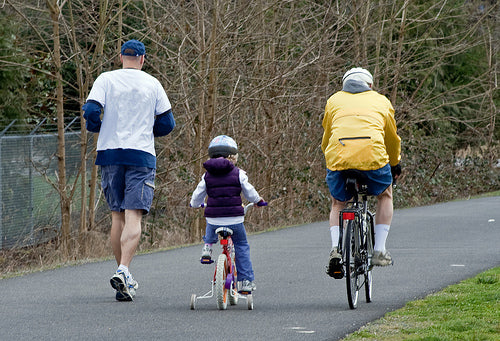"Stress-Free" Exercise: Biking for Health
Posted by JB Smith, Co-Owner on

Offering a practical and environmentally-friendly workout, biking is a perfect activity to take up this spring. is Already a common sight in Europe, from small quiet villages to big fast-paced cities, the growing number of bike lanes in neighborhoods on our side of the pond is making it easier and safer for us to start wheelin’.
Biking can be a daily part of life if your commute allows it, saving bounds in gas prices while keeping your body fit. Take a day trip alone or make it a family affair. Or use your bike as your preferred mode of transportation – it’ll certainly get you places faster than walking!
Make the Right Kind of Impact on Your Health
Not only can biking be easily integrated into your lifestyle, but it has the added benefit of being pretty darn good for you. Even at a slow pace on even ground, biking burns calories, great for weight loss and overall fitness. As little as half an hour per day can cut your heart risk in half without putting strain on the heart and is good for blood circulation. As an aerobic exercise, biking helps lower blood pressure and has been shown to reduce the risk of adult onset Type 2 diabetes when adopted as a routine activity.
Biking can also strengthen parts of the body, like the glutes and legs, without creating severe impact on your joints. It’s easier on your body than the constant pounding of running. Despite the lower stress to the body, your muscles still get their workout, especially as they have to tense up to maintain balance on the bike.
Put the Pedal to the Medal, But What to Wear on the Pedal?
When trying on shoes for biking, do make sure that they fit comfortably. You might overlook the importance of the right footwear – after all, you’re sitting down the whole time! But your feet don’t simply take a time out while you’re biking, so make sure that the sizing and form is correct for your feet. You want to look for a fit that allows your toes some room to move around. Shoes should support your arch well and keep your heel in place as your legs pump the pedals.
While specially-designed biking shoes are available for hardcore mountain biking or racing, as a casual cyclist you won’t have to add anything too fancy to your wardrobe. When your focus is to simply be able to bike for pleasure and/or light exercise (and be able to walk comfortably afterward!), you can get away with a lightweight hiking shoe with a stiffer sole or with a multi-purpose sneaker. With a wide and stable outsole and a cushioned and durable midsole, a good cross-training shoe is versatile and supportive enough to take you from biking to whatever your next activity will be.
One thing to look out for? Long and unruly laces. While laces offer you the ability to customize the fit of your shoes better than Velcro or buckles, you should be careful with them while riding. Either find shorter laces or make sure the ends are tucked into your shoes or socks so that they don’t get caught while riding.
Nick the Pain and Focus on the Gain
Biking can be responsible for aches and pains, just like most physical activities. Riders sometimes experience numbness or burning in the nerves clustered around the bones at the balls of the feet (metatarsalgia) or sharp pain resulting from the thickening of nerves between the toe joints (Morton’s neuroma). The right shoe style and fit will help to minimize this; opt for a roomier toe box and try loosening the laces a bit. A stiffer sole will distribute pressure evenly as your feet push against the pedals. Certain insoles can be used to relieve pressure on the nerves in this area. You can also play around with the thickness of socks – the amount of natural fat padded your foot bones will direct what kind of socks to wear.
And remember, always wear a helmet!
